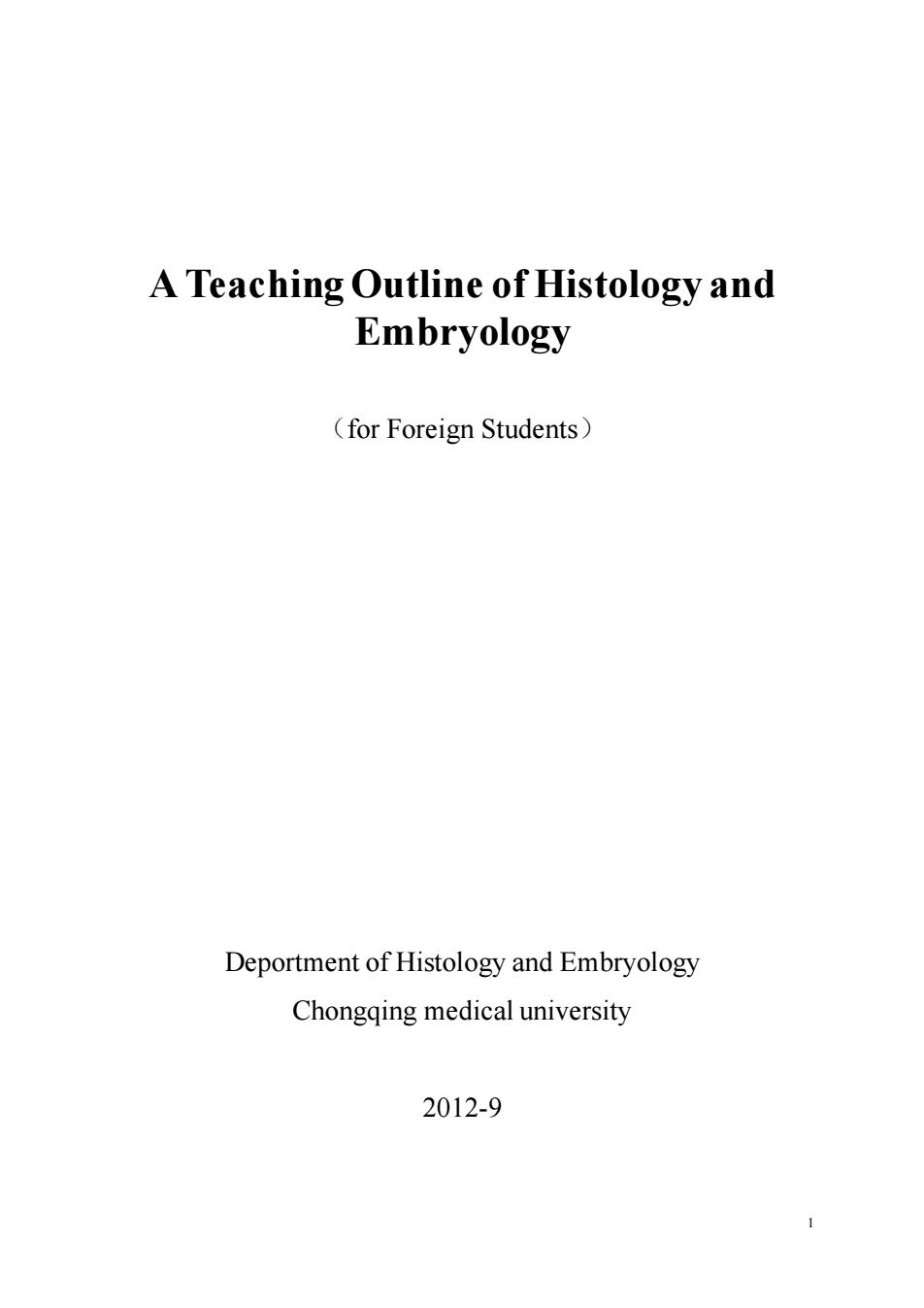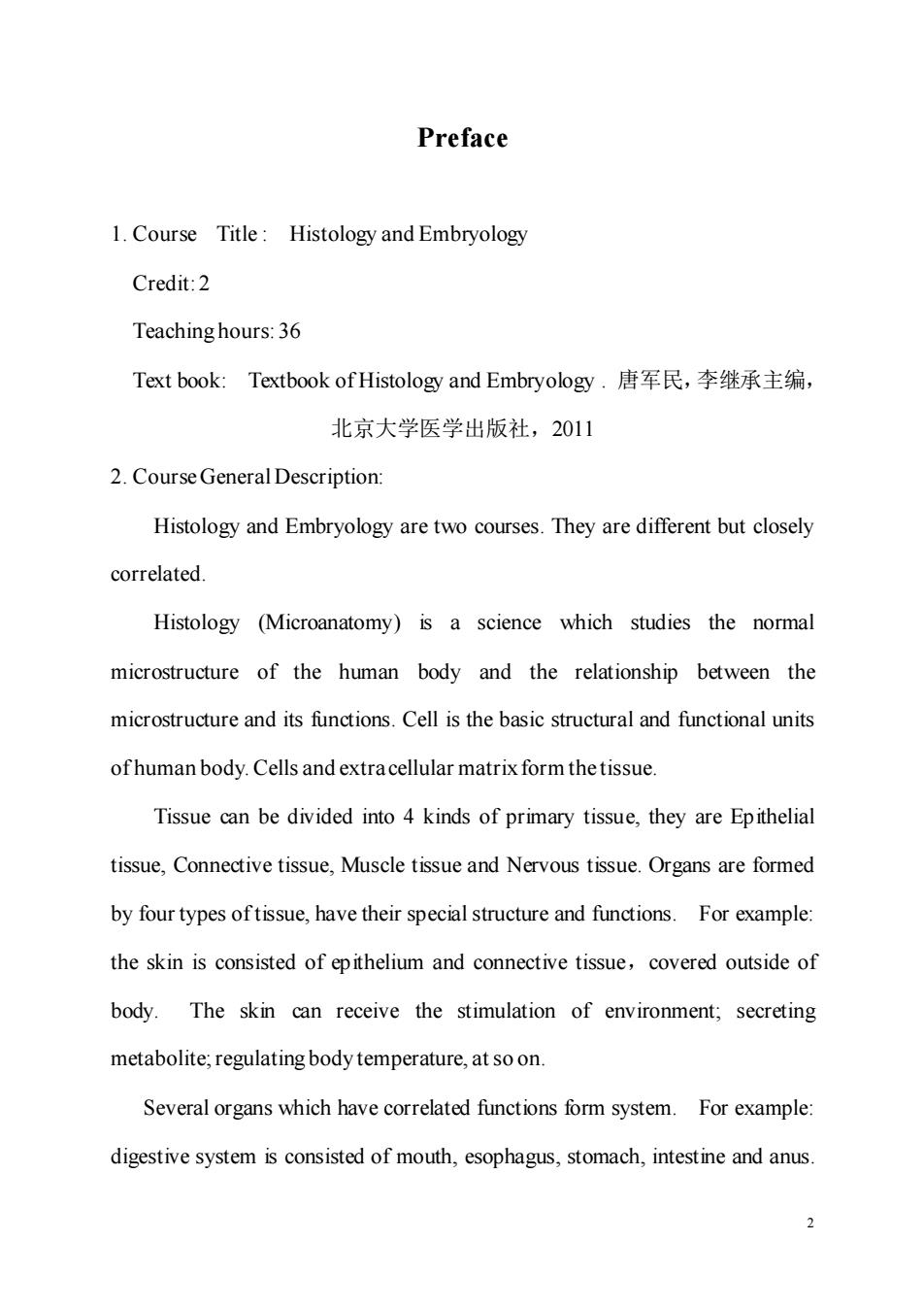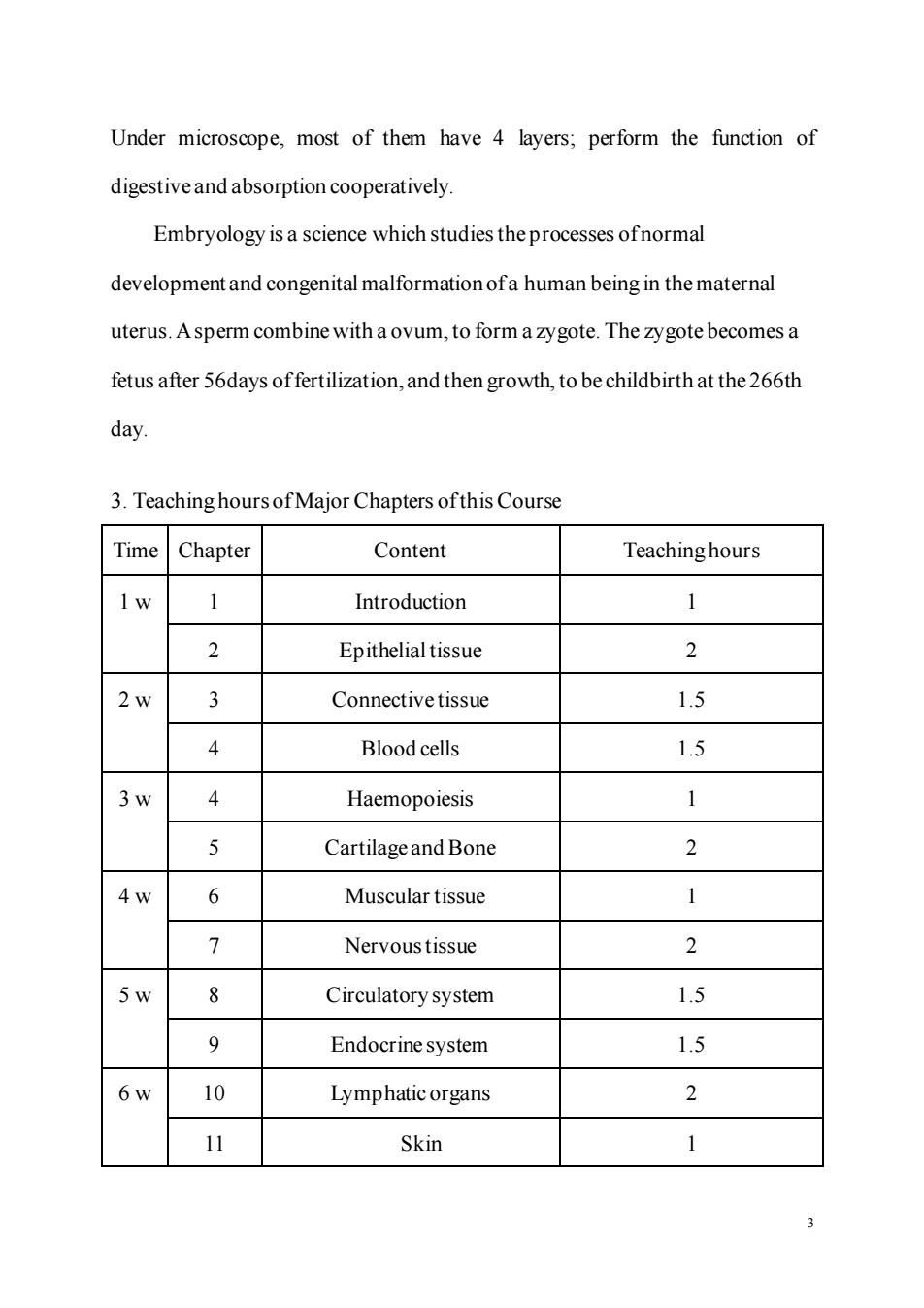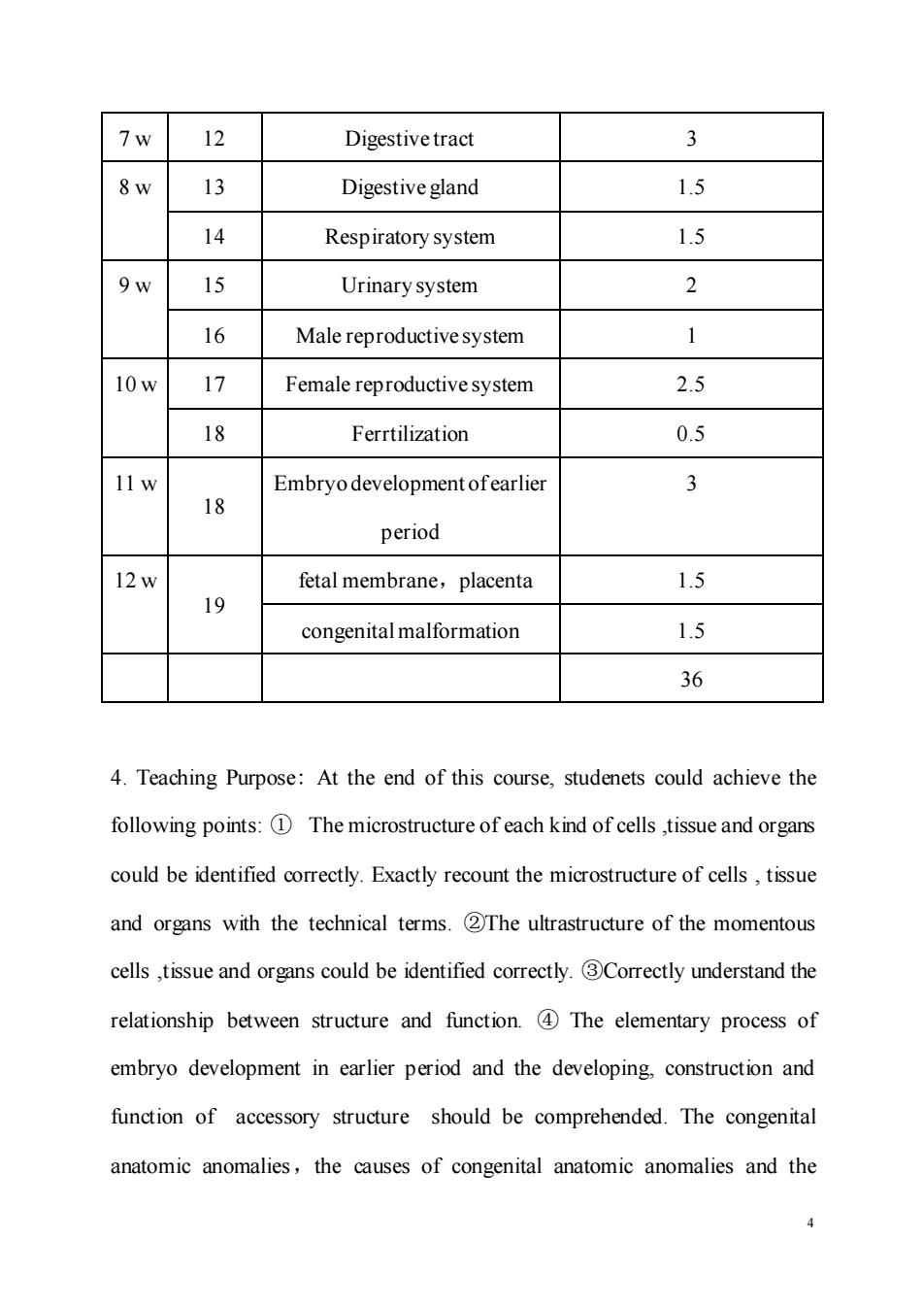
A Teaching Outline of Histology and Embryology for Foreign Students) Deportment of Histology and Embryology Chongqing medical university 2012-9
1 A Teaching Outline of Histology and Embryology (for Foreign Students) Deportment of Histology and Embryology Chongqing medical university 2012-9

Preface 1.Course Title:Histology and Embryology Credit:2 Teaching hours:36 Text book:Textbook of Histology and Embryology.唐军民,李继承主编, 北京大学医学出版社,2011 2.Course General Description: Histology and Embryology are two courses.They are different but closely correlated. Histology (Microanatomy)is a science which studies the normal microstructure of the human body and the relationship between the microstructure and its functions.Cell is the basic structural and functional units ofhuman body.Cells and extracellular matrix form thetissue. Tissue can be divided into 4 kinds of primary tissue,they are Epithelial tissue,Connective tissue,Muscle tissue and Nervous tissue.Organs are formed by four types oftissue,have their special structure and functions.For example the skin is consisted of epithelium and connective tissue,covered outside of body.The skin can receive the stimulation of environment;secreting metabolite;regulating body temperature,at so on. Several organs which have correlated functions form system.For example: digestive system is consisted of mouth,esophagus,stomach,intestine and anus
2 Preface 1. Course Title : Histology and Embryology Credit: 2 Teaching hours: 36 Text book: Textbook of Histology and Embryology . 唐军民,李继承主编, 北京大学医学出版社,2011 2. Course General Description: Histology and Embryology are two courses. They are different but closely correlated. Histology (Microanatomy) is a science which studies the normal microstructure of the human body and the relationship between the microstructure and its functions. Cell is the basic structural and functional units of human body. Cells and extra cellular matrix form the tissue. Tissue can be divided into 4 kinds of primary tissue, they are Epithelial tissue, Connective tissue, Muscle tissue and Nervous tissue. Organs are formed by four types of tissue, have their special structure and functions. For example: the skin is consisted of epithelium and connective tissue,covered outside of body. The skin can receive the stimulation of environment; secreting metabolite; regulating body temperature, at so on. Several organs which have correlated functions form system. For example: digestive system is consisted of mouth, esophagus, stomach, intestine and anus

Under microscope,most of them have 4 layers;perform the function of digestive and absorption cooperatively. Embryology is a science which studies the processes ofnormal development and congenital malformation ofa human being in the maternal uterus.Asperm combine with aovum,to form azygote.The zygote becomesa fetus after 56days offertilization,and then growth,to be childbirth at the 266th day 3.Teaching hours of Major Chapters ofthis Course Time Chapter Content Teaching hours lw 1 Introduction 1 2 Epithelial tissue 2 2w Connectivetissue 1.5 4 Blood cells 1.5 3w 4 Haemopoiesis 1 5 Cartilageand Bone 2 4w 6 Muscular tissue 1 Nervoustissue 2 5w 8 Circulatorysystem 1.5 9 Endocrine system 1.5 6w 10 Lymphatic organs 2 11 Skin 3
3 Under microscope, most of them have 4 layers; perform the function of digestive and absorption cooperatively. Embryology is a science which studies the processes of normal development and congenital malformation of a human being in the maternal uterus. A sperm combine with a ovum, to form a zygote. The zygote becomes a fetus after 56days of fertilization, and then growth, to be childbirth at the 266th day. 3. Teaching hours of Major Chapters of this Course Time Chapter Content Teaching hours 1 w 1 Introduction 1 2 Epithelial tissue 2 2 w 3 Connective tissue 1.5 4 Blood cells 1.5 3 w 4 Haemopoiesis 1 5 Cartilage and Bone 2 4 w 6 Muscular tissue 1 7 Nervoustissue 2 5 w 8 Circulatory system 1.5 9 Endocrine system 1.5 6 w 10 Lymphatic organs 2 11 Skin 1

7w 12 Digestivetract 3 8w 13 Digestive gland 1.5 14 Respiratory system 1.5 9w 15 Urinary system 2 16 Male reproductivesystem 1 10w 17 Female reproductive system 2.5 18 Ferrtilization 0.5 11w Embryo development ofearlier 3 18 period 12w fetal membrane,placenta 1.5 19 congenital malformation 1.5 6 4.Teaching Purpose:At the end of this course,studenets could achieve the following points:The microstructure of each kind of cells,tissue and organs could be identified correctly.Exactly recount the microstructure of cells,tissue and organs with the technical terms.2The ultrastructure of the momentous cells,tissue and organs could be identified correctly.Correctly understand the relationship between structure and function.The elementary process of embryo development in earlier period and the developing,construction and function of accessory structure should be comprehended.The congenital anatomic anomalies,the causes of congenital anatomic anomalies and the
4 7 w 12 Digestive tract 3 8 w 13 Digestive gland 1.5 14 Respiratory system 1.5 9 w 15 Urinary system 2 16 Male reproductive system 1 10 w 17 Female reproductive system 2.5 18 Ferrtilization 0.5 11 w 18 Embryo development of earlier period 3 12 w 19 fetal membrane,placenta 1.5 congenital malformation 1.5 36 4. Teaching Purpose: At the end of this course, studenets could achieve the following points: ① The microstructure of each kind of cells ,tissue and organs could be identified correctly. Exactly recount the microstructure of cells , tissue and organs with the technical terms. ②The ultrastructure of the momentous cells ,tissue and organs could be identified correctly. ③Correctly understand the relationship between structure and function. ④ The elementary process of embryo development in earlier period and the developing, construction and function of accessory structure should be comprehended. The congenital anatomic anomalies,the causes of congenital anatomic anomalies and the

critical periods in human prenatal development should be grasped 5 Understanding the commonly used technique in Histology and Embryology,as paraffin section,ultrathin section,immunohistochemistry and culture in vitro. 5.Teaching Approach:Instructors should study this outline,and grasp the focal points and difficult points.The new progress could be added in teaching. Instructors should recommend the teaching resources in the network of our university,and pay attention to the students,to conduct their autonomicstudy. 6.Checking Modality:Final theory test of semester.In the process of caurse, check on work attendance and answer question will be considered. 7.Reference (1)William K.Ovalle.Netter's Essential Histology.W.B.Saunders Company, 2008 (2)Keith L.Moor.Before We Are Bore.6th ed.W.B.Saunders Company,2003 (3)Keith L.Moor.The Developing Human 8th ed.W.B.Saunders Company, 2008 (4)Junqueira LC.et al.Basic Histology(9th Ed).Stanford:Appleton&Lange, 1998 (5)SadlerIV.Langman's Medical Embryology(8th ed).Philadelphia: LippincottWilliams Wilkins,2000 (6)William J.Larsen.ofHuman Embryology,PHD.Churchill Livingston,1998 (7)James C.McKenzie Robert M.Klein,Basic concepts in cell biology and histology,.北京大学医学出版社2003 5
5 critical periods in human prenatal development should be grasped ⑤ Understanding the commonly used technique in Histology and Embryology,as paraffin section,ultrathin section,immunohistochemistry and culture in vitro. 5. Teaching Approach: Instructors should study this outline, and grasp the focal points and difficult points. The new progress could be added in teaching. Instructors should recommend the teaching resources in the network of our university, and pay attention to the students,to conduct their autonomic study. 6. Checking Modality: Final theory test of semester. In the process of caurse, check on work attendance and answer question will be considered. 7. Reference (1) William K. Ovalle. Netter`s Essential Histology.W.B.Saunders Company, 2008 (2) Keith L.Moor. Before We Are Bore . 6th ed. W.B.Saunders Company, 2003 (3) Keith L.Moor. The Developing Human 8th ed. W.B.Saunders Company, 2008 (4) Junqueira LC. et al.Basic Histo1ogy(9th Ed).Stanford:Appleton&Lange, 1998 (5) SadlerⅣ . Langman’s Medical Embryology(8th ed) . Philadelphia : LippincottWilliams&Wilkins,2000 (6) William J. Larsen. of Human Embryology ,PHD.Churchill Livingston, 1998 (7) James C. McKenzie Robert M. Klein, Basic concepts in cell biology and histology, 北京大学医学出版社 2003